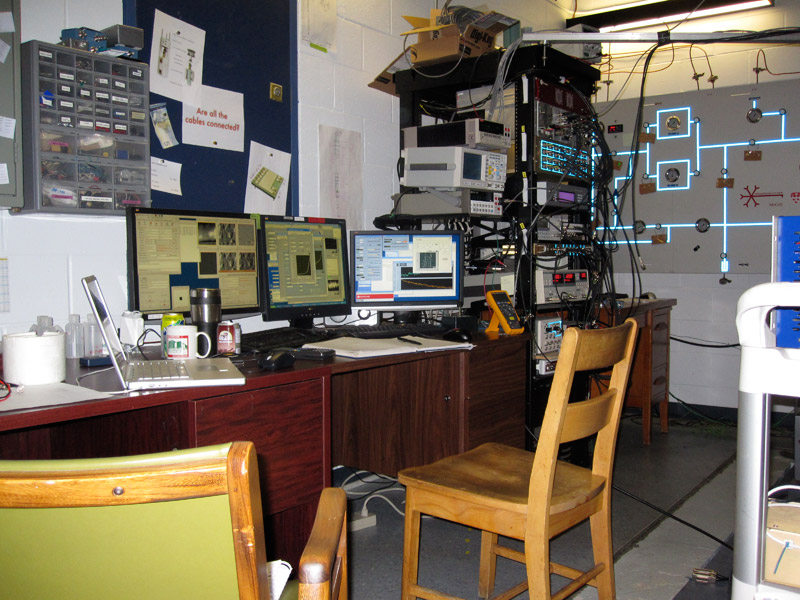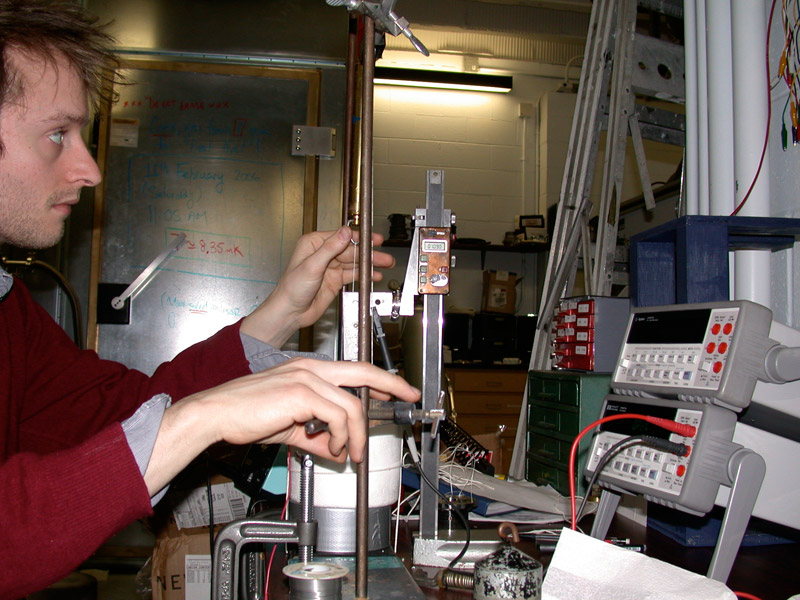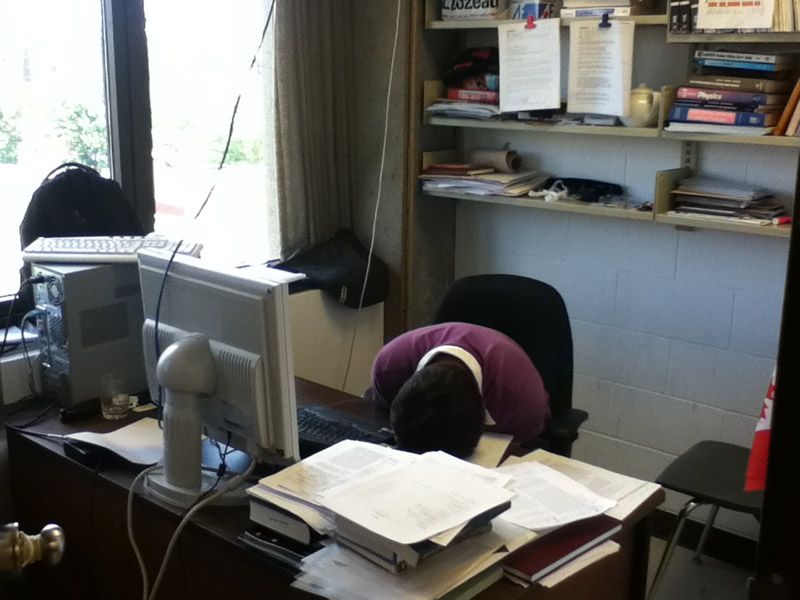The Craft of Experimental Physics
February 1, 2015
In the basement of the Argosy Book Store, I found a collection of essays from 1933. The one that prompted the purchase of the book was entitled: The Craft of Experimental Physics, by P.M.S. Blackett. Though written more than 80 years ago, the salient points are just as relevant today. I might go so far as to say it should be required reading for both newcomers to the field, as well as for established lab rats. Aside from a few ‘old fashioned’ tendencies (gender specific pronouns being the most notable) and dated technologies mentioned (a valve is a vacuum tube), the essay should resonate with all who have spent a few years poking around the dark corners of Nature with their fingers. Here are some selected passages. (A link to the whole pdf is below)
For the experimental physicist is a Jack-of-All Trades, a versatile but amateur craftsman. He must blow glass and turn metal, though he could not earn his living as a glassblower nor ever be classed as a skilled mechanic; he must carpenter, photograph, wire electric circuits and be a master of gadgets of all kinds; he may find invaluable a training as an engineer and can profit always by utilising his gifts as a mathematician. In such activities will he be engaged for three-quarters of his working day. During the rest, he must be a physicist, that is, he must cultivate an intimacy with the behaviour of the physical world.
In this opening paragraph, Blackett sums it up perfectly. My days, especially the early ones, in the lab were indeed spent with carpentry, photography (digital of course these days), soldering, and often needing to incorporate a new device (gadget) on the fly, sometime with no manual or instructions to serve as a guide. I myself never had to blow any glass, though friends of mine did, but I sure turned some metal now and then. All the meanwhile, one couldn’t lose sight of the bigger goal — to do some physics.

The experimental physicist must be enough of a theorist to know what experiments are worth doing and enough of a craftsman to be able to do them. He is only preeminent in being able to do both.
This line captures another aspect well. Not only must we know how to do things, we must at least have a good inclination as to why. Like the famous quote from that dinosaur movie: “…but your scientists were so preoccupied with whether or not they could that they didn’t stop to think if they should.” Of course we weren’t battling over moral dilemmas (that much) but more so over the question of what would we achieve by measuring something. So you can measure the voltage with nanovolt precision – but will it help?
Certainly the way of a researcher is hard who does not in some degree delight in handy work for its own sake. However much his theoretical interest may be excited by the problem he is to investigate, he may feel a certain dismay on being assigned a room empty perhaps of all but a table, a blow-pipe and a few tools. Often two years may elapse before definite results come in sight; two years occupied with carpentering, metal work, glassblowing, and the wiring of electric circuits. Even when an apparatus is completed, an endless succession of minor difficulties and mishaps may postpone its successful use. A glass tube may crack overnight, a single hair may short circuit an electrometer, a filament may burn out, or the failing of the water supply may wreck an elaborate apparatus. But almost the worst trials to the experimenters patience are due to leaks, and a considerable portion of his time is often spent in finding them. An experimenter was once heard to complain, I have spent two days in getting the leak in my apparatus so small that it will now take me a week to find it. If the experimenter does not find pleasure in such activities, that is, if he has not in some degree the temperament of the amateur craftsman, much of his work must be a weariness.
My first day in the lab, in 2005, I painted the floor. It was great. Part of the instrument that I was to work on lay in a coffin-like wooden box, in pieces. Other parts didn’t exists yet. There was pvc pipe to be hung, hundred of meters of wire to direct, and many other tasks that might at first glance seem not very physics related.

And of course, let’s be humble about the whole thing also:
Taken singly, the qualities of hand and mind required to make a good experimental physicist are not rare.
Indeed. None of us were truly talented craftsmen. I did build a table out of an old crate, and it worked well for years, (it might even still be there) but it would hardly be worthy of a spot on a showroom floor.

Nor would most of us have gotten very far in the math olympiads. But, as is pointed out in the subsequent sentence,
But the combination of these abilities in one individual with the right temperament to use them to the full is rare.
it requires more than just steady hands and a way with math to do the physics. It requires a subtle combination of patience, stubbornness, determination, and even some cowboy-esque roping to get the job done.
Blackett then goes on, in such a polite way, to highlight a major issue with experimental physics that persists today: working with the machine shop.
The rapidity with which an alteration to an apparatus can be carried out is a matter of primary and not of secondary importance. If a days work is required to test out an idea, it may be done; if a weeks work, it may not be done at all.
So even when professional assistance is available, many experimenters prefer to make their own apparatus, however amateurishly. It is very often so very much quicker. For if the aid of a mechanic is called in, scale drawings will have to be made, and it is often easier to construct a small piece of complicated apparatus than to make a drawing of it
While my PhD was not finished in record time, it would have taken twice as long if every threaded hole had to be formally requested and accompanied by shop drawings. Sure, there were some parts of the apparatus that were well beyond my abilities in the shop, and those we handed over to the highly trained professionals (often aided by computer controlled machining capabilities). But having the ability to simply run over to a drill press and tap a 1/4-20 hole was indispensable. I couldn’t imagine having to ask every time I needed the smallest bit of machining done.

The middle section of the essay is spent discussing three technologies that were common at the time: the scintillator, amplification (via tubes), and the cloud chamber. Scintillators are still used today to observe radiation. Of course our amplifiers are no longer based on vacuum tubes, but no lab could function without the solid state versions. The cloud chamber has little presence in today’s labs, but the evolution of that technology can be seen in today modern particle detectors.
The third and final section of essay makes some interesting points about how the experimental physicist might, by the very nature of his hands-on approach to the world, be in a good position to understand physics. Essentially, Blackett makes the argument that our intuition gained from a mechanistic interaction with the world might be of some advantage in trying to navigate the abstractions of modern physics. While very much the case for introductory physics topics, I’m not convinced that experience, however measured and probing it may be, with the macroscopic, human scale objects of daily life, can really be a strong source of conceptual foundation for much of what comes out of modern theoretical physics land. Perhaps occasionally, but I usually felt my rootedness in the mechanical world to be a bit of a handicap when exploring the abstract landscape of theory.
The separation between theorist and experimentalist will more than likely be a constant feature of the practice of natural science. There are of course exceptions to be found in the historical record, and in the current era – now and then, some people get really good at both. As is discussed in the essay, the experimentalist most likely has not the time nor the resources to become a fully functional theorist, and the theorists, in general, seem uninterested in arts and crafts. Exactly what leads one towards a particular camp is most likely a factor of both our innate circuitries as well as what filled our days during our youths. I had a neighbor who regularly deposited old stereos and other small appliances on my doorstep when I was young. I would dismantle, and occasionally re-mantle these gifts. There were numerous sets of blocks, legos, logs, and other construction elements in my hands at all time. I’m guessing those sorts of things had something to do with the paths I followed.
The experimental physicist is luckier; his legitimate field of activity ranges from carpentering to quantum mechanics; it is his job to make and think, and he can divide his time as he thinks fit between both these pleasurable occupations.
Exactly.

Here is a link to the whole pdf. It really is a fantastic read and affirms much of the wonderful aspects of being involved in natural science.
Share on: